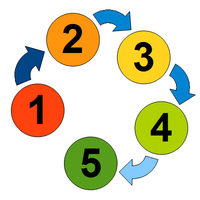PGDEL/DECP04/Unit1
Contents
Instructional Design and E-learning
Introduction
You are assigned a task to do by your teacher. So what will you do next? You will make a plan how to do the task in an efficient and effective manner. You will plan and design the way you will be executing the task. Consciously and unconsciously we approach any new task by making a plan and design for successful execution of that task. It is also true for teaching learning activities. Whenever conference or seminar or debate or any activity is organised, if it is planned and designed well it is likely to be implemented to successful completion. Designing is realised an essential part of any activity. You must have felt during your school years that some classes were better planned and structured than others. The reason being that the effectiveness of any instructional programme or instructional material depends upon an appropriate planning or designing, what is called in professional parlance, Instructional Design. Nowadays Instructional Design (ID) is the buzzword in education. What does an Instructional Designer do? Instructional Design is relatively a young discipline. Let us try to understand the term by understanding the two words it is made up of , Instruction and Design. Instruction means a set of events that facilitate learning. Design is a generic term, which means a creative pattern. You must have heard about designer clothes, watches. It means that the particular thing was patterned for a specific purpose or person. Hence, it is unlikely to have two things to be exactly same. Designing depends on need analysis, experience and creative inputs. Therefore, the purpose of designing instruction is to create situations that enhance learning opportunities of the individuals. This reflects that instruction to become effective has to be uniquely designed based on need and many other factors which are studied by instructional designers. To put it simply ‘Instructional Design is the plan of action with a purpose’
Definitions of Instructional Design
Instructional Design is defined as “a systematic process that is employed to develop education and training programs in a consistent and reliable fashion” (Reiser & Dempsey, 2007).
Instructional design increases the possibility of learning besides encouraging learners to learn faster and gain deeper levels of understanding.
Instructional design is like an umbrella term. Experts visualize it as a process, science , reality and a discipline.
Instructional Design as a Process:
Instructional Design is the systematic development of instructional specifications using learning and instructional theory to ensure the quality of instruction. It is the entire process of analysis of learning needs and goals and the development of a delivery system to meet those needs. It includes development of instructional materials and activities; and tryout and evaluation of all instruction and learner activities.
Instructional Design as a Discipline:
Instructional Design is that branch of knowledge concerned with research and theory about instructional strategies and the process for developing and implementing those strategies.
Instructional Design as a Science:
Instructional design is the science of creating detailed specifications for the development, implementation, evaluation, and maintenance of situations that facilitate the learning of both large and small units of subject matter at all levels of complexity.
Instructional Design as Reality:
Instructional design can start at any point in the design process. Often a glimmer of an idea is developed to give the core of an instruction situation. By the time the entire process is done the designer looks back and she or he checks to see that all parts of the "science" have been taken into account. Then the entire process is written up as if it occurred in a systematic fashion.
Instructional design, is a system or process of organizing learning resources to ensure learners achieve established learning outcomes. As such, it is essentially a framework for learning.
Concept
Instructional Design
Learning Design
Blended Learning Design
Models and Theories
Theories and models are integral part of any discipline. They help in understanding the area of study provides framework for future work.
Difference Between Models and Theories
If we look at definitions Theory refers to an explanation of an event that has been supported by consistent, repeated experimental results and has therefore been accepted by most scientists. Whereas Model refers to verbal, mathematical, or visual representation of a scientific structure or process, which allows scientists to construct and test inferences and theories. Dorin, Demmin and Gabel in 1990 attempted to distinguish the theory from model though you may find people using both interchangeably. According to them theory has following features- • A theory provides a general explanation for observations made over time. • A theory explains and predicts behavior. • A theory can never be established beyond all doubt. • A theory may be modified. • Theories seldom have to be thrown out completely if thoroughly tested but sometimes a theory may be widely accepted for a long time and later disproved. Whereas model is explained as -- A model is a mental picture that helps us understand something we cannot see or experience directly. A Model is defined as a schematic description of a system, theory, or phenomenon that accounts for its known or inferred properties and may be used for further study of its characteristics. Examples are economic model; instructional design model; or instructional systems design model. A model can present complex information in a simpler way. Models can also provide frameworks for theory development and research. Models can be procedural (describing how something works) or conceptual (describing components and the relationships between these components).

